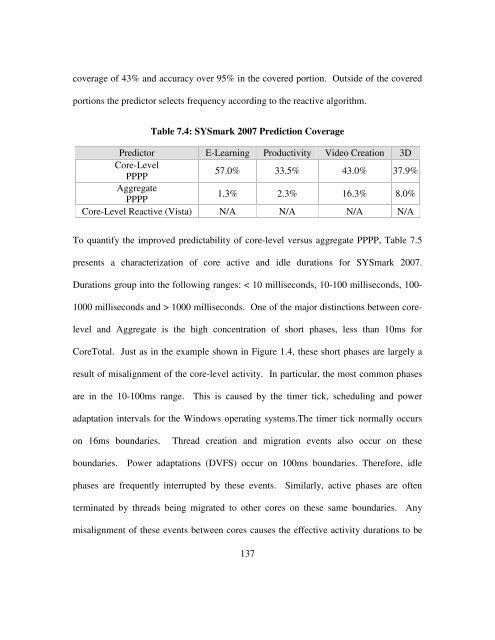Copyright by William Lloyd Bircher 2010 - The Laboratory for ...
Copyright by William Lloyd Bircher 2010 - The Laboratory for ...
Copyright by William Lloyd Bircher 2010 - The Laboratory for ...
You also want an ePaper? Increase the reach of your titles
YUMPU automatically turns print PDFs into web optimized ePapers that Google loves.
coverage of 43% and accuracy over 95% in the covered portion. Outside of the covered<br />
portions the predictor selects frequency according to the reactive algorithm.<br />
Table 7.4: SYSmark 2007 Prediction Coverage<br />
Predictor E-Learning Productivity Video Creation 3D<br />
Core-Level<br />
PPPP<br />
57.0% 33.5% 43.0% 37.9%<br />
Aggregate<br />
PPPP<br />
1.3% 2.3% 16.3% 8.0%<br />
Core-Level Reactive (Vista) N/A N/A N/A N/A<br />
To quantify the improved predictability of core-level versus aggregate PPPP, Table 7.5<br />
presents a characterization of core active and idle durations <strong>for</strong> SYSmark 2007.<br />
Durations group into the following ranges: < 10 milliseconds, 10-100 milliseconds, 100-<br />
1000 milliseconds and > 1000 milliseconds. One of the major distinctions between core-<br />
level and Aggregate is the high concentration of short phases, less than 10ms <strong>for</strong><br />
CoreTotal. Just as in the example shown in Figure 1.4, these short phases are largely a<br />
result of misalignment of the core-level activity. In particular, the most common phases<br />
are in the 10-100ms range. This is caused <strong>by</strong> the timer tick, scheduling and power<br />
adaptation intervals <strong>for</strong> the Windows operating systems.<strong>The</strong> timer tick normally occurs<br />
on 16ms boundaries. Thread creation and migration events also occur on these<br />
boundaries. Power adaptations (DVFS) occur on 100ms boundaries. <strong>The</strong>re<strong>for</strong>e, idle<br />
phases are frequently interrupted <strong>by</strong> these events. Similarly, active phases are often<br />
terminated <strong>by</strong> threads being migrated to other cores on these same boundaries. Any<br />
misalignment of these events between cores causes the effective activity durations to be<br />
137




